Thanks and Farewell to Noreen Weeden
An interview conducted by Melissa Ramos
On Friday, January 17th, Noreen Weeden, Golden Gate Bird Alliance’s extraordinary Director of Volunteers, retired from her position. A former GGBA board member and chair of the San Francisco Conservation Committee, Noreen joined the GGBA staff in 2005. In addition to her work with GGBA, she’s volunteered with the Golden Gate Raptor Observatory, and the Yerba Buena chapter of the California Native Plant Society. Noreen’s passion for habitat restoration has led to phenomenal breakthroughs at San Francisco’s Pier 94, among other habitat restoration projects throughout the Bay Area. Before signing on full-time to GGBA, Noreen worked in tech for large corporations and small businesses. We are in eternal awe and gratitude for Noreen’s dedication and contributions to GGBA.
Before she retired, Noreen sat down for an interview with Melissa Ramos, GGBA’s new Communications Manager.
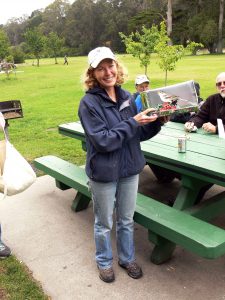
Melissa: Can you describe the first time you realized you were passionate about birds? How did you get into birding?
Noreen: Well, I was always interested in getting outside and going hiking. Going outside was a way to escape from my indoor telecommunications job. Bigger escapes included vacations to places such as Central America and Mexico where, at the time, they couldn’t reach me by phone. Birds quickly became a way to further enjoy nature. Going on bird walks in those places helped me notice that some of the birds in the south traveled to and from San Francisco! From that point on, I wanted to learn more about bird migration.
My love of birding started with those Mexico and Central American trips, but over time I really wanted to learn a lot more about birds in general. There are so many different species and so many different aspects about birds. There’s listening to their songs and their calls. Watching their behavior. Learning about evolution. The different foods they eat and different dangers that they face. Some that migrate long distances and others short. All of this is pretty fascinating and a gateway to virtually all of the other nature sciences.
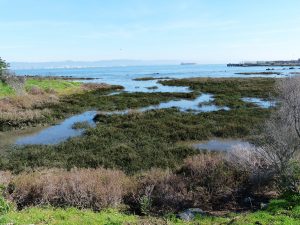
Melissa: What are your favorite birds and why?
Noreen: This has got to be one of the cryptic birds, like the Wilson’s Snipe, a bird that’s sometimes difficult to see even though you’re looking directly at it. And Burrowing Owls! They’re incredibly charismatic.

Melissa: Can you describe how birding went from a casual activity to one of environmental activism?
Noreen: I’ve been interested in the environment since childhood. Beginning in the 2000s, I began volunteering with GGBA and the Golden Gate Raptor Observatory as a way to learn a lot more about birds. The threats to birds became more apparent through these activities. I became more involved in working on solutions. Volunteering at Heron’s Head Park and Pier 94 further illustrated environmental challenges that birds and humans share.
Due to time constraints, volunteering is a one-time event for many people; but long standing and recurring issues require longer term commitments. Following initial restoration activities, maintenance is often required to ensure biodiversity goals are being met. GGBA evaluates the site to see what works, or doesn’t, and adjusts. For example, a native plant might not do well in a particular year or area, but another native plant thrives. We have been able to sustain these restorations because of GGBA’s 100 plus year legacy of conservation and long term vision. This conservation work and collecting data has enabled us to look at trends over time to inform our current restoration process. If you look at the changes in the Bay Area over time, all of this information becomes increasingly valuable for discovering how birds respond, and guides future restoration project planning.
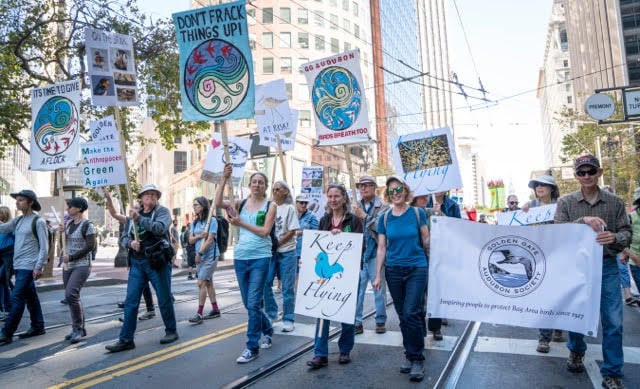
Melissa: What has been your favorite conservation project?
Noreen: It’s a toss-up between habitat restoration and the bird safe buildings. These are both changes that hopefully provide healthy habitats for birds while protecting birds from the built environment.
Melissa: Why did you sign on with GGBA 16 years ago?
Noreen: I was at a GGBA field trip in Golden Gate Park and one of the board members asked me to volunteer on the SF Conservation Committee. I did, and discovered what a wonderful group of caring and knowledgeable people were involved. My involvement evolved from there.
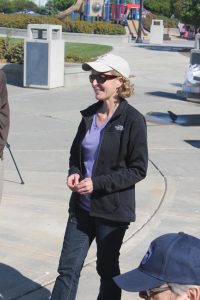
Melissa: What challenges do you see the new generation of birders facing? How do you think they can overcome these challenges?
Noreen: One barrier is seeing the bird. Optics are really important. And optics (binoculars) can be expensive. The first hurdle may be financial for many. I didn’t have a pair of binoculars when I was growing up! And most young people don’t. To overcome some potential financial hurdles, you can go on a free GGBA field trip where field trip leaders usually have a spotting scope. Docents and field trip leaders can provide great views through those optics. New birders can also meet up with docents, who share the use of binoculars or a spotting scope, informing and enabling people to see and learn about birds. Fortunately, lower cost good binoculars are becoming increasingly available. Birding is as an investment that can last a lifetime.
In the Bay Area –and this is a more generalized issue– another one of our biggest challenges is at the shoreline. So many shorebirds depend on mudflats. With the anticipated rising of sea levels, that amount of land on the coastal edge will be smaller. On top of development right up to the shore, this next loss of land is going to be a big concern for shorebirds. This will be a challenge for birders too. People can help by calling for living shorelines at public meetings and support Golden Gate Bird Alliance in advocating for solutions. We need to stand up for birds.
A hopeful development today is the growing movement for local biodiversity. Planting local, native plants that provide food or nesting, or resting habitat in your own space or at one of the GGBA restoration sites, is a great way to help out. Become informed by attending GGBA speaker series that have this biodiversity theme at several upcoming programs.
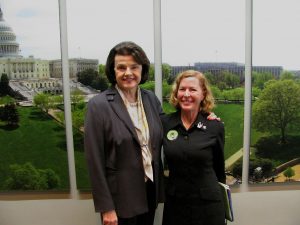
Melissa: How would you encourage someone to volunteer or get in to environmental conservation?
Noreen: One of the great things about GGBA is that you can contribute in a way that is meaningful to you. There are people that love databases and they have been able to help with data and reporting needs, for instance. Some people love to bake and they will always contribute their baking skills for GGBA events. Active outdoor people can plant native plants or remove invasive weeds and shoreline debris, and learn more about the local environment. If you can identify bird species, you can conduct bird surveys. Others enjoy socializing and talking with people at local festivals and events. There are volunteer field trip leaders and trained docents that share their knowledge of birds with members and the public. Office volunteers contribute by prepping materials at the GGBA office for events. Conservation committee volunteer members research local bird and habitat conservation issues, write letters, or attend and speak at public meetings. Eco Education volunteers assist at family friendly field trips. Writers can submit blogs. There are so many wonderful ways to participate!
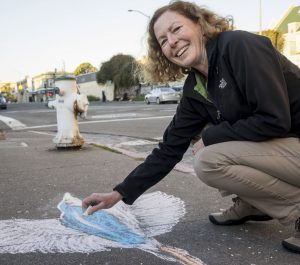
Melissa: What has been your favorite part about working at GGBA?
Noreen: The best part has been getting to know so many caring people. The staff and the many, many volunteers. Really, it’s been thousands of volunteers! Even when people have only a few hours, they find that they are contributing to something that’s meaningful. It’s inspiring to see so many people get involved for birds and our environment.
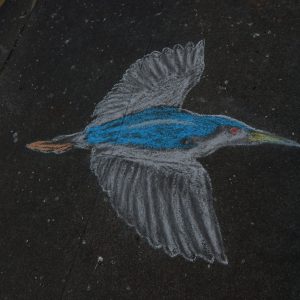
Melissa: Any parting words with fellow volunteers and members?
Noreen: It has been encouraging that the number of volunteers has grown and that so many volunteers have stayed with GGBA for a long time. Now, experienced volunteers train new volunteers, so they are sharing knowledge. New volunteers are contributing new ideas. This will keep the organization going strong into the future in helping to solve some of the major challenges that we face.
But also, GGBA is a great community. There are volunteers that aren’t “birders” but they love participating because this is a wonderful group of people! This has been a fantastic experience and I will continue as a volunteer myself. GGBA is a place where you can work with new ideas and bring ideas to life. That’s what makes Golden Gate Bird Alliance an incredible, positive force of change.
Many thanks to Noreen for her work at Golden Gate Bird Alliance.
Have a message for Noreen? Want to thank her for her 16 years of service at GGBA? Email her at noreen@naturetrip.com.
